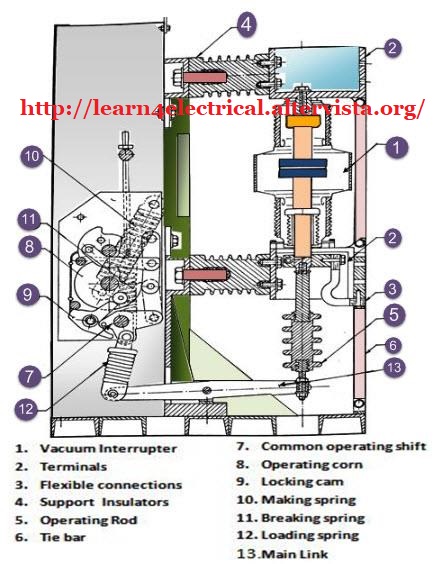Construction:
The vacuum circuit breaker comprises a steel arc chamber in the center-symmetrically arranged ceramic insulators. The pressure inside the vacuum interrupter is maintained below 10^-4 torr.
The material used for current carrying contacts plays an important role in the performance of the vacuum circuit breaker. The alloys like, Copper-bismuth or copper-chrome are the ideal material to make VCB contacts.
It consists of a fixed contact, a moving contact and a vacuum interrupter. The moving contact is connected to the control mechanism by stainless steel bellow. The arc shields are supported o the insulating housing such that they cover on these shields, and is prevented from condensing on the insulating enclosure.
The possibility of a leak is eliminated due to permanent sealing of vacuum chamber for that a glass vessel or ceramic vessel is used as the outer insulating body.
Working of Vacuum Circuit Breaker:
The sectional view of vacuum circuit breaker is shown in the figure below when the contacts are separated due to some abnormal conditions, an arc is struck between the contacts, the arc is produced due to ionization of metal ions and depends very much on the material of contacts.
The arc interruption in vacuum interrupters is different from other types of circuit breakers. The separation of contacts causes the release of vapor which is filled in the contact space. It consists positive ions liberated from contact material. The vapor density depends on the current in the arc.
When the current decreases, the rate of vapor release decreases and after current zero, the medium regain its dielectric strength if the vapor density is reduced. When current to be interrupted is very small in a vacuum, the arc has several parallel paths.
The total current is divided into many parallel arcs which repel each other and spread over the contact surface. This is called diffused arc which can be interrupted easily.
At high values of current, the arc gets concentrated in a small region. It causes rapid vaporization of the contact surface. The interruption of the arc is possible if arc remains in diffused state. If it is quickly removed from the contact surface, the arc will be re-strike.
Arc extinction in vacuum breakers is greatly influenced by material and shape of the contacts and the technique of considering metal vapor. The path of the arc is kept moving so that temperature at any one point will not be high.
After the final arc interruption, there is rapidly building up of dielectric strength which is peculiar of the vacuum breaker. They are suitable for capacitor switching as it will give a re-strick free performance.
The small current is interrupted before natural current zero, which may cause chopping whose level depends on the material of contact.
Advantages of VCB:
Vacuum offers the utmost insulating strength. So, it has extreme superior arc quenching properties than any other medium.
- The vacuum circuit breaker has a long life.
- Unlike Oil Circuit Breaker (OCB) or air blast Circuit Breaker (ABCB), the explosion of VCB is avoided. This enhances the safety of the operating personnel.
- No fire hazards.
- The vacuum CB is fast in operation so ideal for fault clearing. VCB is suitable for repeated operation.
- Vacuum circuit breakers are almost maintenance free.
- No exhaust of gas to the atmosphere and Noiseless operation.
Disadvantages of Vacuum Circuit Breaker:
- The main disadvantage of VCB is that it is uneconomical at voltages exceeding 38 kV.
- The cost of the breaker becomes excessive at higher voltages. At high voltages (above 38 kV) more than two circuit breaker are required to be connected in series.
- Moreover, the VCBs production is uneconomical, if produced in small quantities.

